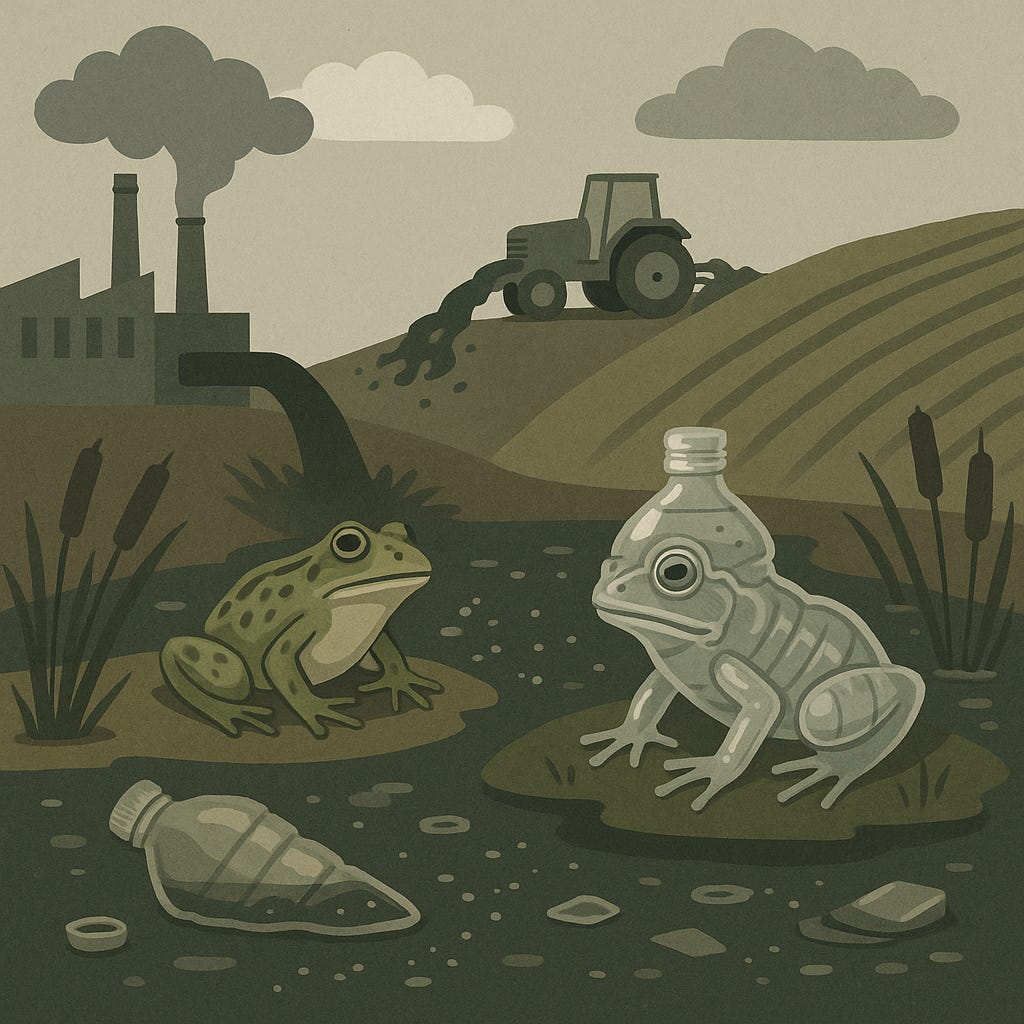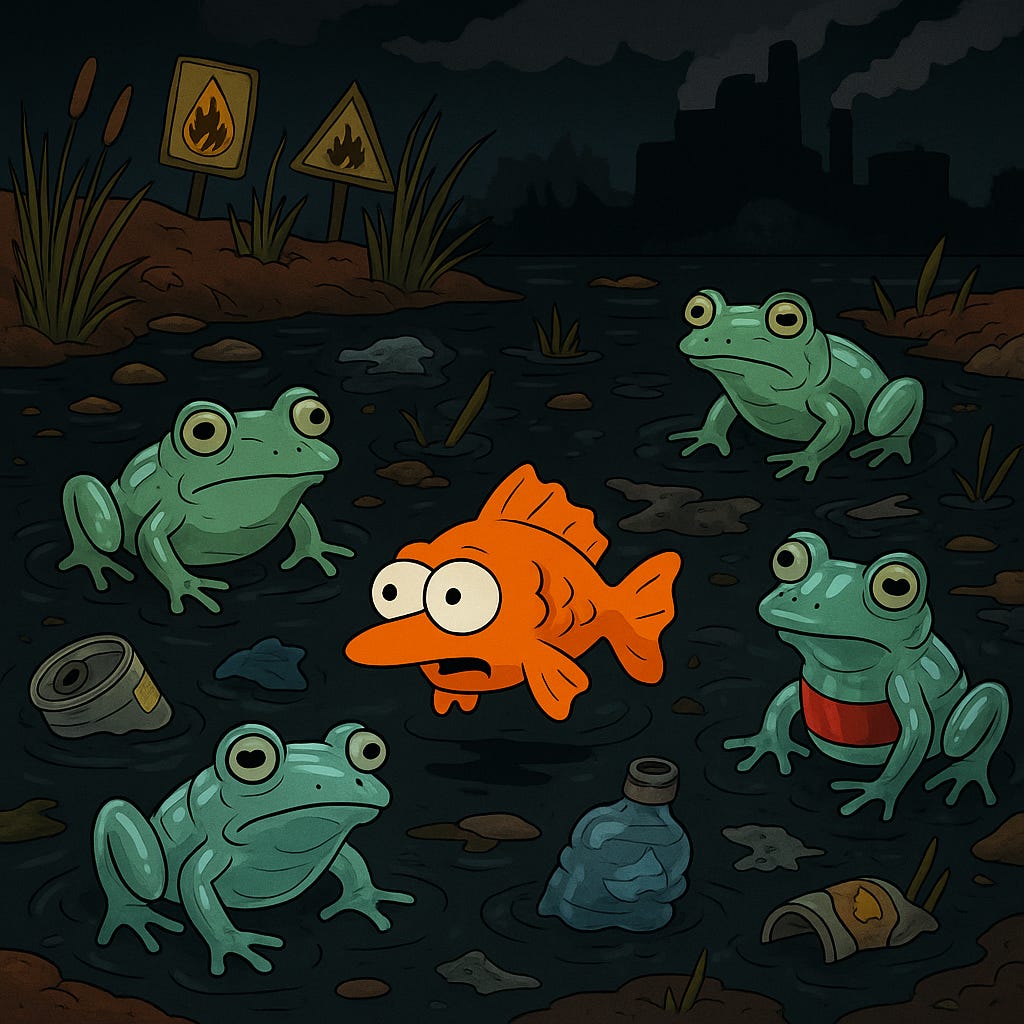When Frogs Croak Plastic: A Warning We Can’t Ignore
Frogs have always been our ecological early‑warning system.
If they’re thriving, the ecosystem is thriving.
But now the chorus has changed. In wetlands, forests, and even remote alpine ponds, frogs aren’t just croaking anymore—they’re crinkling.
Microplastics—those fragments smaller than five millimeters—are accumulating inside them. Not just in their stomachs, but in their muscles, organs, and reproductive tissues.
Every hop, every flex of a plastic‑laced leg, risks another internal injury.
What Are Microplastics, and Why Are Frogs Full of Them?
Microplastics are born when larger plastics—bags, bottles, fishing line—break down into tiny fragments. They also come from synthetic fabrics, microbeads in cosmetics, and tire dust.
They’re now pervasive in soil, water, and air (National Geographic).
They don’t dissolve, and living creatures mistake them for food or simply absorb them through skin and gills.
Ocean Blue Project reports:
Frogs, like fish and birds, are already showing measurable microplastic loads in their tissues—proof that even amphibians, once thought insulated, are being infiltrated by plastic pollution (Ocean Blue Project).
🐸 The Evidence From the Field
👉 Marsh frogs in Turkey
16.6% of sampled frogs contained microplastics—fibers and fragments of PET, PE, EVA, PP, and PTFE embedded in gastrointestinal tissue (Environmental Sciences Europe).
👉 Common frogs in Alpine ponds
Even in pristine high-altitude ponds with no microplastics in water or sediment, every adult frog tested had plastic fibers (polyamide, polyethylene, PET) in its tissues—likely through terrestrial exposure or contaminated prey (MDPI Diversity Journal).
👉 Lab studies on tadpoles and juveniles
Controlled exposures to microplastics lead to intestinal lesions, inflammatory responses, developmental delays, and increased mortality (Environmental Toxicology and Chemistry).
⚠️ How Microplastics Hurt Frogs
Amphibians live through their skin and gut—they don’t have the protective buffers many mammals do. A frog’s movement is powered by strong jumps and twists, but with plastic shards embedded in tissue, every leap becomes a gamble.
🌎 Why This Should Alarm Us
Frogs aren’t just “some animals.”
They are keystone species—pollinator allies, insect regulators, and water‑quality indicators.
If they are collapsing under a load of microplastics, that load is moving up the food web… straight to us.
We already know microplastics are in human placentas, lungs, and bloodstreams.
If frogs in remote, so‑called pristine environments are riddled with synthetic fibers, it means no corner of the planet is truly safe.
💀 The Policy Backdrop
Let’s not pretend this happened in a vacuum.
Frogs aren’t turning into plastic because of some mysterious act of God. This is policy. This is choices.
In the past decade, protections that kept waterways even marginally clean were gutted.
Under Trump, the EPA was hollowed out, staffed with fossil‑fuel lobbyists and deregulation fanboys who rewrote the very rules they were sworn to enforce. The Clean Water Act—the backbone of America’s wetlands protection—was hacked apart in Sackett v. EPA (2023) after Trump’s appointees on the Supreme Court redefined “waters of the United States” so narrowly that countless streams and marshes lost federal safeguards overnight.
Translation: more farm runoff, more industrial discharge, more plastics and chemicals dumped without oversight… straight into the habitats amphibians rely on.
And while that was happening, the EPA’s microplastics research programs were defunded, enforcement budgets slashed, and regional offices starved of staff.
Trump bragged about cutting “job‑killing regulations.”
What he actually cut were the last guardrails keeping our frogs—and us—from swimming in trash.
🧨 It’s Not Just About Frogs
The rollbacks didn’t just hurt a few wetlands. They opened the floodgates for contamination that we now eat, drink, and breathe.
Frogs are our bio‑indicators, sure.
But they’re also our canaries in a coal mine that politicians like Trump have set on fire for donor applause.
Frogs have always been our early alarm.
When they vanish, ecosystems unravel.
When they’re full of plastic and flinching with every hop, it’s not just their problem—it’s a mirror of our own future.
Listen to the crinkle.
Because if we don’t, it won’t just be the frogs hurting.
✋ What Can We Do?
Stop the source:
Reduce single-use plastics. Support bans on microbeads and synthetic microfibers.Clean up the mess:
Support organizations like Ocean Blue Project that actively remove plastics from waterways.Push for policy:
Demand better waste management, stormwater filtration, and agricultural runoff controls in your community.Fund research:
More studies mean better data—and better leverage for policy changes.












